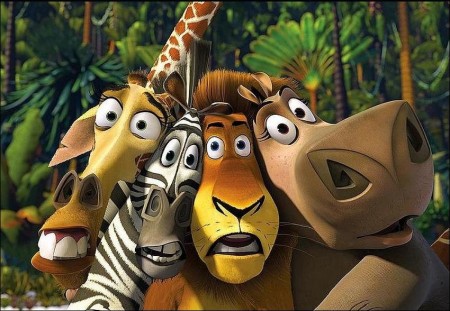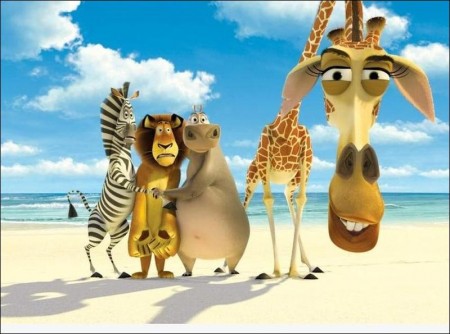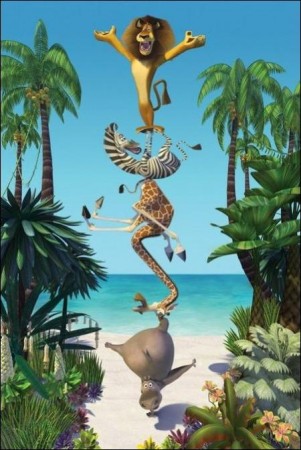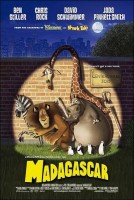Alex the Lion is the king of the urban jungle as the main attraction at New York’s Central Park Zoo. He and his best friends Marty the Zebra, Melman the Giraffe and Gloria the Hippo have lived their entire lives in blissfully ignorant captivity, complete with lavish meals and their own park views.
Not content to leave well enough alone, Marty allows his curiosity to get the better of him and, with the help of some prodigious penguins, makes his escape to explore the world he’s been missing, intending to return before morning. In the middle of the night, Alex, Melman and Gloria discover their friend missing and decide the only course of action is to break out of the zoo and get Marty back home before anyone notices they’re gone.
Even in New York City, a lion, giraffe and hippopotamus wandering the streets and riding the subway are bound to attract some attention. Alex, Melman and Gloria manage to track Marty down in Grand Central Station, but before they can catch the train to the zoo, they are darted, captured, crated, put on a ship to Africa.
When those plotting penguins sabotage the ship, Alex, Marty, Melman and Gloria find themselves washed ashore on the exotic island of Madagascar. Now, these native New Yorkers have to figure out how to survive in the wild and discover the true meaning of the phrase “It’s a jungle out there.”
About the Production: Zookeepers
In just 10 years, computer animation has eclipsed the rest of the animation field and emerged as one of the most successful film art forms of all time, with DreamWorks Animation’s “Shrek 2” topping the list. The “Shrek” films are the best examples to date of how the animation and effects teams at PDI/DreamWorks have pushed the edge of the envelope in areas like facial animation and recreating lifelike people and realistic worlds in the computer. The chasm between these advances in animation and those classic cartoons of our youth has seemed ever-widening. But now, everything old is new again…
Led by writer / directors Eric Darnell and Tom McGrath, the teams at DreamWorks Animation and PDI/DreamWorks employed state-of-the-art computer animation to achieve an old-fashioned cartoon look that pays homage to the best of such animation legends as Chuck Jones and Tex Avery.
McGrath expounds, “Our influences were some of the best of classic animation going back to the 1930s and `40s, where a lot of the comedy was derived from the movement and the animation of the characters. We knew this film had to have that kind of comedy. It needed to be broad; it needed to be slapstick.”
Darnell adds, “Our characters are very stylized and not based on reality, so we could have a lot of fun with how they looked and how they moved. They are very 2D inspired, but created in the 3D world of the computer. It gave us a lot of license because this is clearly a cartoon.”
Producer Mireille Soria agrees. “This film is definitely more cartoony than anything we’ve done before. We applied that style to the characters and to the overall design of the movie.”
The cartoon comedy style of “Madagascar” called for the computer animators at PDI/DreamWorks to be able to apply a visual cue called “squash and stretch” to the characters. A hallmark of classic cartoons, squash and stretch is the process an animator uses to deform an object and then snap it back into shape to convey motion or impact. Easy to do with a pencil, squash and stretch is much more difficult to accomplish in the computer.
“In the past, the amount of squash and stretch you could get in the computer was very limited, so one of the biggest technical challenges we faced was getting the kind of broad comedy we wanted,” McGrath attests. “The people at PDI/DreamWorks created a system that took it to the next level, where the animators could push and pull and stretch objects way out without breaking them.”
Jeffrey Katzenberg, CEO of DreamWorks Animation SKG, comments, “The technology of computer-animated movies continues to be explosive, but even though all the bells and whistles are fantastic, what they really do is empower our storytellers to imagine more. We don’t have 200 `mad scientists’ trying to invent gizmos that we then have to figure out how to use. It’s the reverse of that. We come up with the story knowing we’re going to need a lot of special tools to bring it to life… and that’s what those 200 mad scientists go off to do,” he laughs. “Ultimately, it’s all about telling a great story.”
The initial story concept for “Madagascar” started with a single question: What would happen if you took four New York City zoo animals out of the civilized world in which they’d lived their entire lives and dropped them into the middle of a savage jungle?
Eric Darnell notes, “It’s a classic fish-out-of-water premise, and so many fun ideas spring from it. You just describe that basic idea and everybody gets it. That’s always what you want, especially with an animated film-an idea you can say in one sentence and people’s eyes light up. If you see people’s eyes light up, you know you’re on to something.”
Darnell, who directed DreamWorks Animation’s first computer-animated release, “Antz,” had originally been working on a different project altogether. He and producer Mireille Soria were developing the then-titled “Rockumentary,” a spoof based on the Beatles’ “A Hard Day’s Night” and starring a group of four penguins. Tom McGrath also came on board the project early on, but, unfortunately, the music clearances involved proved insurmountable and the penguin movie was shelved.
Not long after, the idea for “Madagascar” came along and Darnell, McGrath and Soria jumped at the chance to reunite on a new project, albeit with a very different animal foursome consisting of a lion, a zebra, a giraffe and a hippo. Writers Mark Burton and Billy Frolick were brought on to write the screenplay with Darnell and McGrath.
The framework of the story was relatively straightforward: Four Central Park Zoo animals find themselves shipwrecked on the island of Madagascar, and now these native New Yorkers have to figure out how to survive in the wild. As the comedic possibilities began to take shape, Tom McGrath was charged with figuring out how to get Alex, Marty, Melman and Gloria from ship to shore. The director realized it was the perfect opportunity to resurrect the penguin characters from the earlier movie and give them a new mission. Turning the erstwhile band on the run into a misguided band of brothers, McGrath devised the hilarious sequence in which the penguins are responsible for the “zoosters” becoming castaways.
McGrath reveals, “Originally, the animals’ crates were washed overboard by a massive storm at sea, but I thought that was so overused. I wanted to do something more interesting with it. We had all these animals from the zoo being shipped back to Africa, including the penguins, and the question came up, `Why are penguins going to Africa?’ We thought it would be really funny if the penguins didn’t want to go to Africa. They’re penguins; they want to go to Antarctica. They break out of their crate, take over the ship, and send it into a hairpin turn that throws the crates overboard. We had a lot of fun developing the penguins into a kind of POW unit breaking out of captivity.”
The penguins’ interference sends Alex, Marty, Melman and Gloria on a course to the island of Madagascar. Darnell says that Madagascar was chosen as the setting-and title-of the film because “we needed to find a place that was the polar opposite of Manhattan. The leads in our film are African animals, but everybody’s seen mainland Africa on the screen, and it doesn’t feel quite as exotic as what we were going for.
Madagascar is an island off the coast of Africa that is completely unique, with plants and animals that are unlike anything else in the world. We especially loved the lemurs, which are only found on Madagascar. It is a fantastical place that gave us a lot of freedom to play and to create just the right sort of wild jungle for our heroes to land in.”
Anyone who has seen “Wild Kingdom” or tuned into Animal Planet knows that lions and zebras don’t run in the same circles… unless one of them is running for his life. But in “Madagascar,” predator and prey have become an unlikely band of friends and neighbors.
“Everybody knows that lions eat zebras; it’s just that classic yin and yang,” Darnell states. “But in the Central Park Zoo, these two animals can become best friends in conflict with their natural behavior.”
McGrath offers, “The heart of the story is the relationship between Alex and Marty, who have no idea what their true natures are because they grew up in a civilized environment. Once they are taken from that environment and put back in the wild, their natural instincts start to emerge. That’s when their friendship is put to the test.”
These production notes provided by DreamWorks Pictures.
Madagascar
Starring: Ben Stiller, Chris Rock, David Schwimmer, Jada Pinkett Smith, Devika Parikh
Directed by: Eric Darnell, Conrad Vernon
Screenplay by: Mark Burton, Billy Frolick
Release Date: May 27th, 2005
MPAA Rating: PG for mild language, crude humor and some thematic elements.
Studio: Dreamworks Pictures
Box Office Totals
Domestic: $193,595,521 (36.3%)
Foreign: $339,085,150 (63.7%)
Total: $532,680,671 (Worldwide)



